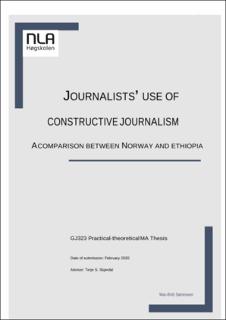| dc.description.abstract | A movement of journalists around the world is talking about a new concept called ‘constructive journalism’. But what is it? And how is it practiced? This thesis together with a supplementary documentary examine how journalists talk about the concept, explain it and practice it. This might be helpful since the concept has been criticized for being defuse. It is critical to find out how a concept may inspire journalists because they are to inform and inspire the public. Constructive journalism can be practiced by looking for solutions, being balanced or facilitating debate (Borg, 2018). In the state broadcaster Amhara Mass Media Agency, in Bahir Dar, Ethiopia, journalists mostly used constructive journalism to create dialogue via local events. This makes much sense in a culture with a history of high levels of self-censorship, imprisonment of journalists and violence between ethnic and religious groups. Further north, in Norway, journalists at ‘Here and Now’ (NRK) use the same concept but without accompanying events. Since they implemented the constructive journalism as a principle in 2017 many ofthe journalists at ‘Here and Now’ noticed changes in their news culture. Through the use of qualitative methods, this study includes 13 in-depth interviews from journalists at AMMA and ‘Here and Now’ as wellas unstructured observations and content analysis from six media productions. The study found some similarities, but also some differences in the way that two different media companies andmedia cultures interpret and practice constructive journalism. The findings support the adaption theory which holds that a concept like constructive journalism will be adapted according to a specific environment. Findings show that both agencies sought to create balance in their news framing by using a deliberate and less adversarial approach. Thus, the concept has universal implications. | en_US |
